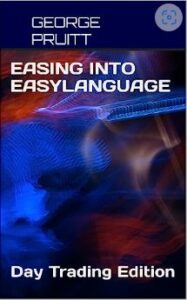Here is a nice template to use when testing a volatility break out system to daytade. Note I haven’t yet finished the filter coding.
{OPEN RANGE BREAK OUT with Trade Management}
{:data1 = 5 minbars
:data2 = daily bars}
inputs: atrLookBack(10),brkOutAmt(.20),initProtStop$(500),profitThresh$(300),percentTrail(0.3),waitNumBars(3),endTradeEntryTime(1430);
inputs: tradeFilterNum(1);
{tradeFilterNum indicates how you want to
filter the trades:
filter #1 : prior day was a narrow range
filter #2 : prior day was a NR4
filter #3 : buy/sell day only base on today's open
filter #4 : combo of filter #1 and filter #3
filter #5 : combo of filter #2 and filter #3
}
vars: buysToday(0),sellsToday(0),atrVal(0),todaysOpen(0),canBuy(false),canSell(false);
vars: trailLong(false),trailShort(false),trailLongStop(0),trailShortStop(999999);
vars: myBuysToday(0),mySellsToday(0);
if tradeFilterNum = 1 then
begin
canBuy = false;
canSell = false;
if range of data2 < avgTrueRange(atrLookBack) of data2 and time < endTradeEntryTime then
begin
canBuy = true;
canSell = true;
end;
end;
if date <> date[1] then
begin
todaysOpen = open; {Capture Today's Open}
trailLongStop = 0;
trailShortStop = 9999999;
myBuysToday = 0;
mySellsToday = 0;
end;
if marketPosition = 1 then myBuysToday = 1;
if marketPosition = -1 then mySellsToday = -1;
atrVal = avgTrueRange(atrLookBack) of data2;
if canBuy and myBuysToday = 0 and marketPosition <> 1 then buy("BBO") next bar at todaysOpen + atrVal * brkOutAmt stop;
if canSell and mySellsToday = 0 and marketPosition <>-1 then sellshort("SBO") next bar at todaysOpen - atrVal *brkOutAmt stop;
if marketPosition <> 1 then trailLong = false;
if marketPosition <> -1 then trailShort = false;
if marketPosition = 1 then
begin
sell("LongExit") next bar at entryPrice - initProtStop$/bigPointValue stop;
if h > entryPrice + profitThresh$/bigPointValue then trailLong = true;
if trailLong then
begin
trailLongStop = maxList(trailLongStop,h - (h - entryPrice)*percentTrail);
sell("LongTrail") next bar at trailLongStop stop;
end;
end;
if marketPosition = -1 then
begin
buyToCover("ShrtExit") next bar at entryPrice + initProtStop$/bigPointValue stop;
if l < entryPrice - profitThresh$/bigPointValue then trailShort = true;
if trailShort then
begin
trailShortStop = minList(trailShortStop,l + (entryPrice - l)*percentTrail);
buyToCover("ShortTrail") next bar at trailShortStop stop;
end;
end;
setExitOnClose;
{finished}









